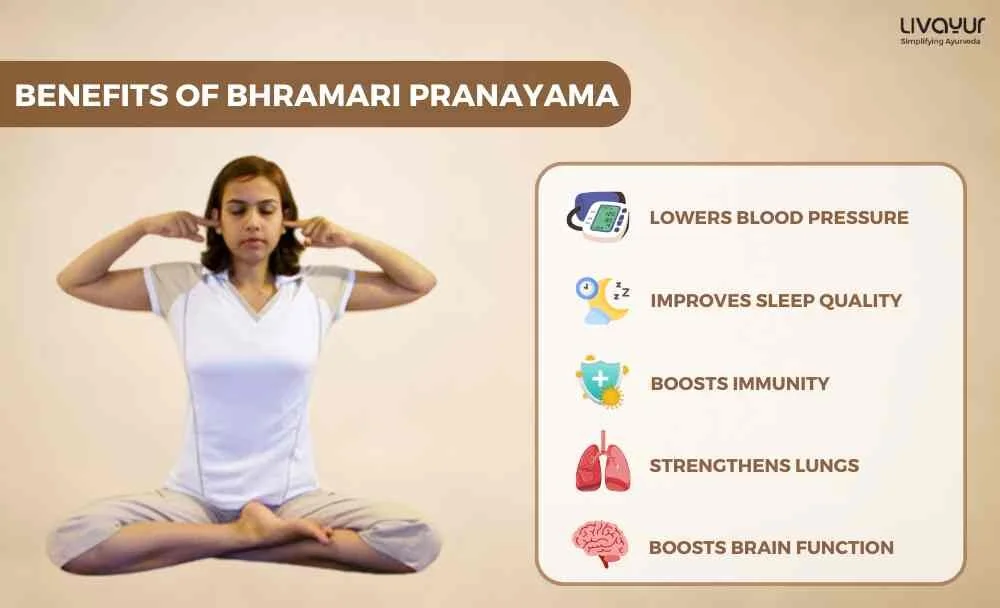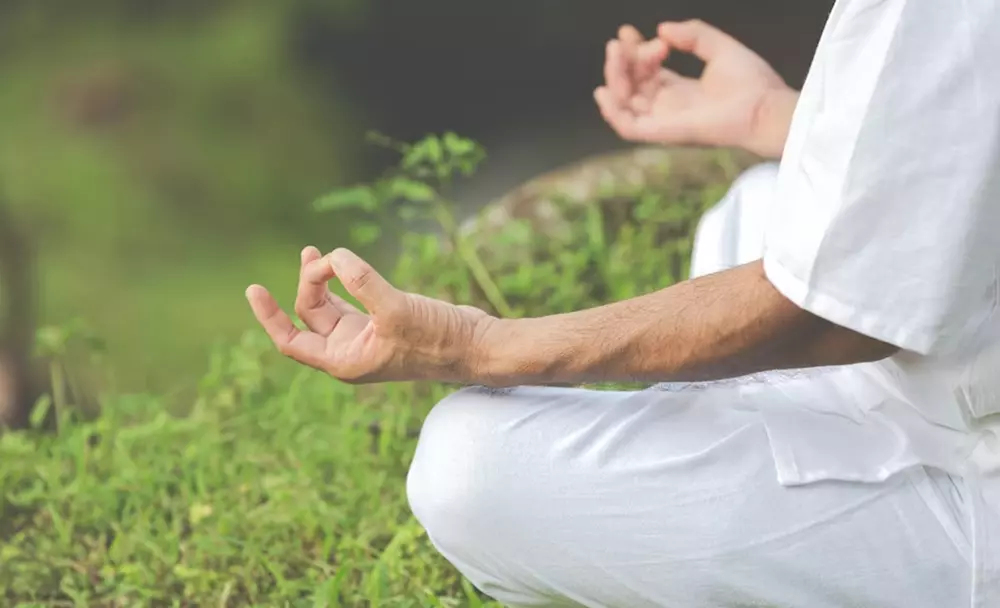This article is reviewed by an expert

Bhramari Pranayama is a yogic breathing technique that involves making a humming sound from the throat as you exhale. It is a slow Pranayama in which you inhale from both nostrils. The word Bhramari means “bee” in Sanskrit, and the sound resembles the buzzing of a bee, giving the pranayama its name of Humming Bee Breath or Bee Breath.
Bhramari Pranayama is one of the eight classical Pranayamas mentioned in the Hatha Yoga Pradipika, a 15th-century text on yoga. It is said to fill the mind of the yogi with bliss and prepare it for meditation. Bhramari Pranayama is also a great way to practice pratyahara (withdrawal of senses) and dharana (concentration).
What Are The Benefits Of Bhramari Pranayama?
Bhramari Pranayama has several benefits for the body and mind, and is highly recommended as a lifestyle strategy to mitigate the health risks associated with our modern lifestyles.
Lower Blood Pressure
Primary Benefits: High blood pressure is one of the most common chronic health conditions in India and is a major cause for chronic kidney disease and heart disease. Research shows that simply practising Bhramari Pranayama for 3 weeks can bring about significant reductions in both systolic and diastolic blood pressure 1.
Sleeping Aid
Primary Benefits: Sleep impairment is a major problem today with most of us experiencing disturbed or poor-quality sleep. Bhramari Pranayama benefits also include better sleep quality, as demonstrated in a study 2. This is most likely connected to its effects of relaxation.
Boosts Immunity
Secondary Benefits: Evidence suggests that Bhramari Pranayama may be an effective lifestyle intervention that can enhance autonomic function and boost immunity, lowering the risk of various infections 3.
Strengthens Lungs
Primary Benefits: All Pranayamas or breathing exercises are known to promote respiratory health as they expand the lungs more than normal. This results in improved breathing patterns and the opening of airways in the lungs. Unsurprisingly, Bhramari Pranayama benefits lung function and health 3.
Better Mental Health
Secondary Benefits: Deep breathing and other breath control techniques are widely used in modern clinical psychology to help patients cope with stress, depression and anxiety disorders. Research shows that Bhramari Pranayama can be used as one such technique to relieve stress or anxiety and depressive disorders 4.
Boosts Brain Function
Secondary Benefits: The effects of Bhramari Pranayama on brain function are well-documented. Just 10 minutes of practice have been shown to improve cognitive function, which can help with learning, problem solving and reaction time 5. Although the precise mechanism of action is not understood, these benefits are most likely connected to improved oxygen supply to the brain and lowered stress levels.
Researchers continue to study other potential Bhramari Pranayama benefits with some experts and yogis suggesting that it can stimulate the vagus nerve, protect vision by enhancing blood flow to the optic nerve and retina, and can also help to regulate and balance hormone levels through stimulation of the pineal gland.
How To Do Bhramari Pranayama?

Bhramari Pranayama can be practiced at any time of the day, but is ideally practiced soon after you wake in the morning or shortly before going to bed at night. To get started simply follow these Bhramari Pranayama steps:
- Sit in a comfortable position, such as the lotus pose
- Close your ears with your index fingers or thumbs
- Inhale deeply through your nose and then exhale slowly through your mouth, making a humming sound from your throat
You can vary the pitch and duration of the sound according to your preference. You can also use different mudras (hand gestures) to enhance the effects of Bhramari Pranayama.
Conclusion
In light of the evidence demonstrating Bhramari Pranayama, integrating its practice into your daily routine could be one of the simplest and most cost-effective strategies to promote health and lower the risk of various lifestyle diseases. Keep in mind that while the practice can be therapeutic, it is always a good idea to also check with your doctor before trying a new breathing exercise or practice.
References:
- https://biomedicineonline.org/index.php/home/article/view/1501
- https://ijop.net/index.php/ijop/article/view/2603
- https://www.sciencedirect.com/science/article/pii/S0975947621001376
- https://www.sciencedirect.com/science/article/pii/S0975947622000559
- https://www.ncbi.nlm.nih.gov/pmc/articles/PMC4097899/

















